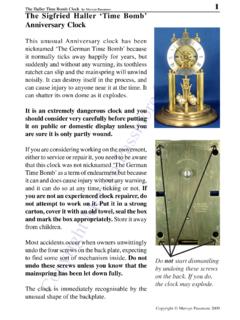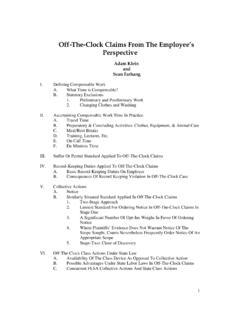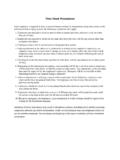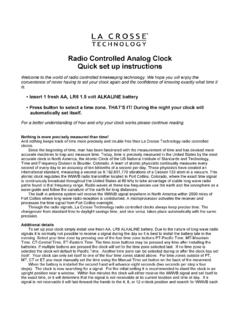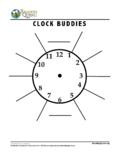Transcription of CLOCK AND W ATCH ESCAPEMENT MECHANICS
1 CLOCK AND WATCH ESCAPEMENT MECHANICSMark V. Headrick (Copyright 1997).Section 1: CLOCK : Efficiency and Power : Drawing an Escape : Drawing the Graham : The Graham : The Importance of the Simulation. 116: The Recoil Escapements. 167: The Brocot ESCAPEMENT . 188: The Pin Wheel : Other Design Considerations. 2010: The Graham Reconsidered. 2211: Efficiency in Numbers. 23 The first nine chapters are explained without math. These chapters are lesscomplicated, and they introduce the reader to the logic behind the drawing techniques, soas to serve the needs of those who want to learn about escapements but would not bedrawing them on their own computers. The tenth chapter explains the math behind theprevious chapters. This way the reader has the option whether or not to become involvedwith the :Britten's Watch & CLOCK Maker's Handbook, Dictionary and Guide (1978 Edition).
2 Donald de Carle: Watch and CLOCK Encyclopedia (1977 Edition).Henry B. Fried: The Watch ESCAPEMENT (1974 Edition).View animations of the escapements in this book on my website 2: Watch : Drawing the Club-Tooth Escape 4113: Drawing the : Changing the : Improving the : The English : The Pin Pallet : The Cylinder : The Duplex : The Chronometer : Daniel's Independent Double-Wheel : The 12 to 18 are similarly presented in order to introduce the reader to thelogic behind the drawings, though these drawings are more involved and require someunderstanding of watch theory, such as lock, drop, draw, and impulse. Chapter 19 andbeyond become more involved with the math that is required to create the drawings. Thereader who does not want to become involved with the math could benefit from the logicof the latter chapters by passing over the would like to thank the following for their invaluable assistance and encour-agement:Daniel HendersonCecil MulhollandRoy HoveySteve ConoverNino GonzalesHarry and Sue Wysong2 Strip-pallet recoilGraham how much more there isto know about escapements by creat-ing your own drawings.
3 The purposeof this project is to introduce thereader, whether professional or hob-byist, to a hands-on method for draw-ing a mechanical CLOCK or watch es-capement. While it is more obviousthat a manufacturer needs to knowhow to design a pallet, the repairmancould do a better repair with an im-proved understanding of design the-ory. The ability to draw an escape-ment enables one to experiment moreeasily with the effects of changing thevariables and to compare differenttypes of escapements, their similari-ties and most important reason forcareful attention to design is effi-ciency. The escapements most fre-quently encountered at the bench arethe Recoil, the Graham (ordead-beat), and the Swiss all have efficiencies below50%.
4 This means that more than halfthe power is lost in the escapementalone, after all the power losses in thegear drawings are not dissimilar to what Ihave seen in ESCAPEMENT literature. They do notreveal the methods by which they were de-signed, why the lines and curves are positionedso. If these drawings ignite your curiosity, thisproject is for : Efficiency and Power CLOCK is usually taken to the shop for repair because the CLOCK fails to keeprunning. It runs for a while and stops because not enough power reaches the pendulum tokeep it running. One way to get it running is to double the weight, but this causes enor-mous wear and consequent damage in the long run. The other way is to overhaul theclock.
5 The job of the repairman is to do whatever is necessary to minimize the powerlosses between the weight and the pendulum. The CLOCK is cleaned. Pivots are bushings are replaced. Adjustments are made to the ESCAPEMENT to improve itsaction. The CLOCK is carefully lubricated. Other repairs are made as needed. These allhave the ultimate goal of reducing power are two kinds of power losses in a CLOCK : frictional losses and losses caused bythe action of the ESCAPEMENT (which result in additional frictional losses). Frictionallosses are easily understood. The lubricant has failed, causing drag. The bushings areworn, so the gear and pinion teeth grind together. The pivots are scored, causingfrictional losses from rough surfaces.
6 Dirt particles become imbedded in the wornbushing, causing binding of the pivot, and so losses caused by the action of the ESCAPEMENT are less obvious. The followingreasons are explained in detail in subsequent chapters. If the escape wheel rotates CLOCK -wise, the force it exerts on the pallet would be in a different direction to that of thepallet's movement. The greater the angle between the two directions, the greater the lossof power as it is transferred from the escape wheel to the pallet. Consider that the palletsrotate clockwise as the escape tooth pushes on the entry pallet, and counterclockwise asthe tooth pushes on the exit pallet, yet the escape wheel continues to rotate in the sameclockwise the escape tooth pushes on the pallet, the tooth exerts a force in thesame direction as its direction of travel at that point.
7 If the point of contacton the pallet were at 90 to this direction, such as on the locking face of theGraham pallet, the escape tooth would not move forwards and no powerwould be transferred to the the point of contact were in the same direction as the escape tooth,so that the pallet's impulse face were parallel to the path of the tooth, thetooth would pass by freely and provide no impulse to the power is transferred to the pallet when the angle is 90 or 0 . An angle inbetween is needed: the angle that maximizes the power transfer. Find what direction theescape tooth is moving in as it passes over the pallet, and the direction of the pallet. Thendetermine the direction in which the pallet should receive power from the tooth.
8 The di-rection should be half way between those of the tooth and of the pallet. For maximumefficiency, the pallet's impulse face needs to be at right angles (90 ) to this the angle between the directions of the tooth and of the pallet were 90 , the maxi-mum achievable efficiency would be only 50%. This is achieved when the impulse face's4angle is at 45 to the direction of the tooth's travel. If the impulse face's angle were 25 ,the efficiency would be merely 38%. That is a 24% power loss caused by improper de-sign. If the repairman could see this, he could adjust the impulse face's angle moreclosely to what it should be, and maximize the pallet's efficiency, given the originaldesign he has to work with.
9 Ideally, the impulse face's angle should be at 90 to the anglehalf way between the directions of the tooth and of the may not find this easy to understand: power losses by ESCAPEMENT design areless obvious. This will become clearer in the next chapters, as we draw the Grahamescapement. It should, however, have become clear to you how important the design ofthe ESCAPEMENT is. I have seen clocks in which one pallet received a negligible impulsefrom the escape wheel, so the maximum achievable efficiency was only 25%. Whywould they would not keep running?2: Drawing an Escape am currently using an IBM with Windows and a drawing program called Key-Draw. If you have AutoCAD, you are well equipped.
10 The most important features youneed are the ability to draw lines and circles on a grid, and the ability to rotate the linesby angles that you determine. You may have a different method. This is just one way todo , draw a large circle. A diameter of 6inches worked well for me. Draw anothercircle of inch diameter and center it insidethe first. Draw a horizontal line across thiscircle, bisecting it. Draw a tooth on one sideuntil you are satisfied: I chose a line at 15 andanother at 25 from horizontal, positioned tofit, and with a small gap to allow for tooththickness. Duplicate, rotate, and place a toothon the other side. Your drawing should looklike this:Move the inner circle outside.
